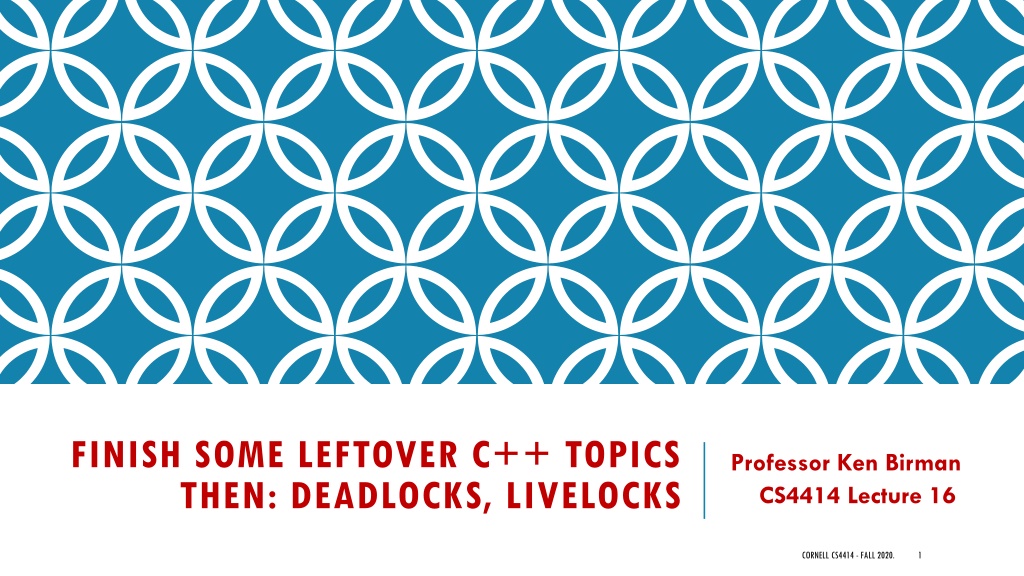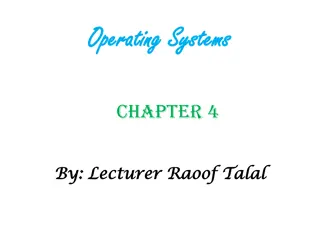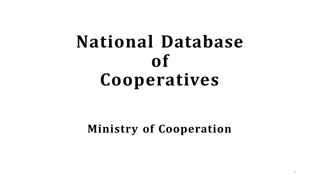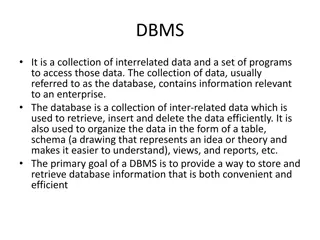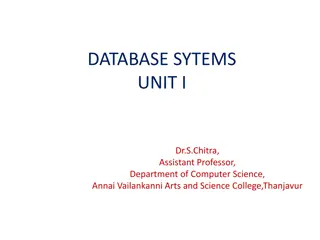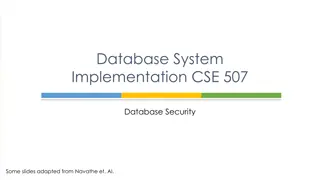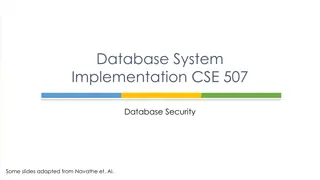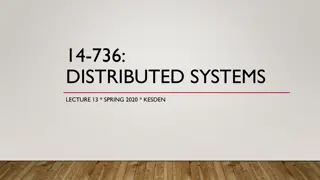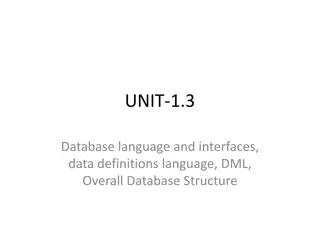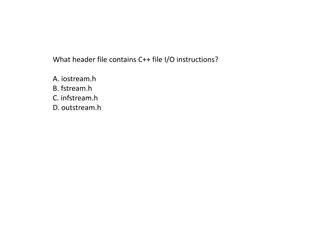Understanding LINQ and boolinq in C++ for Efficient Database and File System Access
Explore LINQ and boolinq in C++ to enhance your database and file system operations with higher-level templated libraries. Learn how to write expressive code resembling database expressions and seamlessly integrate C++ and database operators. Discover key concepts like iterators, pairs, and examples to leverage LINQ for efficient data processing.
Download Presentation

Please find below an Image/Link to download the presentation.
The content on the website is provided AS IS for your information and personal use only. It may not be sold, licensed, or shared on other websites without obtaining consent from the author. Download presentation by click this link. If you encounter any issues during the download, it is possible that the publisher has removed the file from their server.
E N D
Presentation Transcript
FINISH SOME LEFTOVER C++ TOPICS THEN: DEADLOCKS, LIVELOCKS Professor Ken Birman CS4414 Lecture 16 CORNELL CS4414 - FALL 2020. 1
BEFORE WE DIVE IN First, a left over mini-topic: A quick glimpse of boolinq: A way to do database and file system access from C++ that leads to really nice looking code CORNELL CS4414 - FALL 2020. 2
LINQ FOR C++ (BOOLINQ) CORNELL CS4414 - FALL 2020. 3
LINQ AND BOOLINQ LINQ: A family of higher-level templated librarys that support database access or scaning collections of files. Uses a notation popular in ML systems (seen in Pandas/NumPy dialect of Python, Tensor Flow, Spark/Databricks, Julia ). https://xscode.com/k06a/boolinq CORNELL CS4414 - FALL 2020. 4
KEY IDEA Connect to database, file system or key-value storage. Obtain a collection that s supports iterators. Now you can just write expressions that look like database expressions anywhere in your C++ code, and they can mix C++ and database operators very easily. CORNELL CS4414 - FALL 2020. 5
ITERATORS AND PAIRS LINQ centers on: (key, value) pairs. A key could just be a name, a file path, or any unique id. Example: for a database the key is a row-id, value is the row A collection could be std::list, std::map, etc. Iterators: C++ object used in for loops to scan a collection, or a range within a collection. CORNELL CS4414 - FALL 2020. 6
LINQ EXAMPLES Sum the even numbers from an array of integers: int src[] = {1, 2, 3, 4, 5, 6, 7, 8}; auto dst = from(src) .where( [](int a) { return a % 2 == 1; }) // 1, 3, 5, 7 .select([](int a) { return a * 2; }) // 2, 6, 10, 14 .where( [](int a) { return a > 2 && a < 12; }) // 6, 10 .toStdVector(); // dst will be a std::vector with 6, 10 Things to notice: - Code is very succinct - Lots of use of lambdas - Very powerful - Mixes with normal C++ (in fact, is a C++ library) Order descending all the distinct numbers from an array of integers, transform them into strings and print the result. int numbers[] = {3, 1, 4, 1, 5, 9, 2, 6}; auto result = from(numbers) . distinct() . orderby_descending([](int i) {return i;}) . select([](int i){std::stringstream s; s<<i; return s.str();}) . toStdVector(); for(auto i : result) std::cout << i << std::endl; Visit boolinq on GitHub to download, learn more CORNELL CS4414 - FALL 2020. 7
EXAMPLE WITH STRUCTS In a list of friends, find the subset who are under age 18: struct Friends { std::string name; int age; }; Friends src[] = { { Kevin , 14}, { Anton , 18}, { Agata , 17}, Saman , 20}, { Alice , 15}, }; auto dst = from(src).where([](const Friends & who) { return who.age < 18; }) .orderBy([](const Friends & who) { return who.age; }) .select( [](const Friends & who) { return who.name; }) .toStdVector(); // dst type: std::vector<:string> items: Kevin , Agata , Alice CORNELL CS4414 - FALL 2020. 8
EXAMPLE WITH STRINGS In a list of text messages, count the number of messages to Dennis by sender: struct Message { std::string PhoneA; std::string PhoneB; std::string Text; }; Message messages[] = { { Anton , Troll , Hello, friend! }, { Denis , Mark , Join us to watch the game?"}, { Anton , Sarah , OMG! }, { Denis , Jimmy", How r u? }, { Denis , Mark", The night is young! }, }; int DenisUniqueContactCount = from(messages) .where([](const Message & msg) { return msg.PhoneA == Denis ; }) .distinct([](const Message & msg) { return msg.PhoneB; }) .count(); CORNELL CS4414 - FALL 2020. 9
SOME LINQ OPERATORS Filters and reorders: where(predicate), where_i(predicate) take(count), takeWhile(predicate), takeWhile_i(predicate) skip(count), skipWhile(predicate), skipWhile_i(predicate) orderBy(), orderBy(transform) distinct(), distinct(transform) append(items), prepend(items) concat(linq) reverse() cast() Aggregators: all(), all(predicate) any(), any(lambda) sum(), sum(), sum(lambda) avg(), avg(), avg(lambda) min(), min(lambda) max(), max(lambda) count(), count(value), count(predicate) contains(value) elementAt(index) first(), first(filter), firstOrDefault(), firstOrDefault(filter) last(), last(filter), lastOrDefault(), lastOrDefault(filter) toStdSet(), toStdList(), toStdDeque(), toStdVector() Transformers: select(transform), select_i(transform) groupBy(transform) selectMany(transfom) Bits and Bytes: bytes(ByteDirection?) unbytes(ByteDirection?) bits(BitsDirection?, BytesDirection?) unbits(BitsDirection?, BytesDirection?) Coming soon: gz(), ungz(), leftJoin, rightJoin, crossJoin, fullJoin CORNELL CS4414 - FALL 2020. 10
HOW TO CONNECT TO A DATABASE LIKE MYSQL OR ORACLE LINQ requires a connector but you won t have to build it: databases, file systems and key-value stores provide these. You specify the name of the database and the connector returns a collection object that supports iterators. So simply by constructing a connection you can access the data in LINQ. Example: In MySQL, you could use the X-DevAPI. CORNELL CS4414 - FALL 2020. 11
HOW DOES THIS TIE INTO C++ FOR ML? Many machine learning systems are trained on data in vectors, arrays or higher-dimensional tensors. A database query returns a table as a result. Think of the table as a collection of (row-id, row-contents) pairs. Easy to perform in LINQ Finally, we pass the data to ML algorithms expressed as matrix multiplications, eigenvalue computations, etc. We end up with ML code in a high-level form that executes extremely efficiently. CORNELL CS4414 - FALL 2020. 12
NEXT: OUR MAIN TOPIC CORNELL CS4414 - FALL 2020. 13
IDEA MAP FOR THE REST OF OUR LECTURE The monitor pattern in C++ Reminder: Thread Concept Problems monitors solve (and problems they don t solve) Lightweight vs. Heavyweight Thread context Deadlocks and Livelocks C++ mutex objects. Atomic data types. Today we focus on deadlocks and livelocks. CORNELL CS4414 - FALL 2020. 14
DEADLOCK: UNDERSTANDING Deadlock arises in situations where we have multiple threads that share some form of protected object or objects. For simplicity, A and B share X and Y. Now suppose that A is holding a lock on X, and B has a lock on Y. A tries to lock Y, and B tries to lock X. Both wait, forever! CORNELL CS4414 - FALL 2020. 15
MORE EXAMPLES We only have one object, X. A locks X, but due to a caught exception, exits the lock scope. Because A didn t use scoped_lock, the lock isn t released. Now B tries to lock X and waits. Because A no longer realizes it holds the lock, this will persist forever. CORNELL CS4414 - FALL 2020. 16
ACQUIRING A MUTEX TWICE Suppose that A is in a recursive algorithm, and the same thread attempts to lock mutex X more than once. The recursion would also unlock it the same number of times. This is possible with a C++ recursive_mutex object. But the standard C++ mutex is not recursive. CORNELL CS4414 - FALL 2020. 17
WHAT IF YOU TRY TO RECURSIVELY LOCK A NON-RECURSIVE MUTEX? The resulting behavior is not defined. On some platforms, this will deadlock silently. A waits for A! On others, you get an exception, Deadlock would result. CORNELL CS4414 - FALL 2020. 18
MORE EXAMPLES A and B lock X and Y. The developer noticed the deadlock pattern but did not understand the issue. C++ lock primitives have optional timeout arguments. So the developer decided to add a random backoff feature: When locking an object, wait t milliseconds. Initially, t=0 but after a timeout, change to a random value [0..999] Then retry CORNELL CS4414 - FALL 2020. 19
WHAT DOES THIS GIVE US? Now A locks X (and holds the lock), and B locks Y A tries to lock Y, times out, retries forever B tries to lock X, times out, retries forever They aren t waiting yet they actually are waiting! CORNELL CS4414 - FALL 2020. 20
DEADLOCK AND LIVELOCK DEFINITIONS We say that a system is in a deadlocked state if one or more threads will wait indefinitely (for a lock that should have been released). Non-example: A is waiting for input from the console. But Alice doesn t type anything. Non-example:A lock is used to signal a cupcake is ready , but we have run out of sugar and none can be baked. CORNELL CS4414 - FALL 2020. 21
NECESSARY AND SUFFICIENT CONDITIONS FOR DEADLOCK 1. Mutual exclusion: The system has resources protected by locks 2. Non-shareable resources: while A holds the lock, B waits. 3. No preemption: there is no way for B to seize the lock from A. 4. Cyclic waiting: A waits for B, B waits for A (a circular pattern) With recursion using non-recursive locks, A could deadlock by itself CORNELL CS4414 - FALL 2020. 22
CONDITIONS FOR LIVELOCK A livelock is really the same as a deadlock, except that the threads or processes have some way to spin . As a result, instead of pausing, one or more may be spin-waiting. We can define inability to enter the critical section as a wait, in which case the four necessary and sufficient conditions apply. CORNELL CS4414 - FALL 2020. 23
C++ AND LINUX ARE FULL OF RISKS! If you think about it, you can find hundreds of ways that Linux could potentially be at risk of deadlocks! If you code with threads in C++ you run that risk too! The developers of Linux designed the system to be free of deadlock. You can do so in your applications too. But it takes conscious though and a careful design. CORNELL CS4414 - FALL 2020. 24
HOW TO AVOID DEADLOCKS! Acquire locks in a fixed order that every thread respects. This rule implies that condition 4 (cyclic waiting) cannot arise. Example: Recall A and B with X and Y. We had A holding a lock on X and requesting a lock on Y: if our rule says lock X before Y, this is legal and A must wait. Meanwhile B held a lock on Y. Given our rule, B is not allowed to request a lock on X at this point. CORNELL CS4414 - FALL 2020. 25
THIS RULE CAN BE IMPRACTICAL There are many applications that learn what they must lock one item at a time, in some order they cannot predict. So in such a situation, B didn t know it would need a lock on X at the time it locked Y. now it is too late! CORNELL CS4414 - FALL 2020. 26
ON THE OTHER HAND, THE RULE IS USEFUL When you actually can impose an order and respect the rule, it is a very simple and convenient way to avoid deadlock. Ordered locking is very common inside the Linux kernel. It has a cost (an application may need to sort a list of items, for example, before locking all of them), but when feasible, it works. CORNELL CS4414 - FALL 2020. 27
TIMER BASED SOLUTIONS Sometimes it is too complicated to implement orderd locking. So we just employ a timeout. If B is running and tries to get a lock, but a timeout occurs, B aborts (releasing all its locks) and restarts. CORNELL CS4414 - FALL 2020. 28
BACKING OUT AND RETRYING For this purpose, B would employ try_lock . Backout can be costly This is a feature that acquires a lock if possible within some amount of time, but then gives up. If B gets lucky, it is able to lock Y, then X, and no deadlock arises. But if the lock on Y fails, B must unlock X. CORNELL CS4414 - FALL 2020. 29
CONCEPT: ABORT AND RETRY We say that a computation has aborted if it has a way to undo some of the work it has done. For example, B could be executing, lock Y, then attempt to lock X. The try_lock fails, so B releases the lock on X and throws away the temporary data it created it rolls back . Then it can retry, but get a lock on X first. Hopefully this will succeed. CORNELL CS4414 - FALL 2020. 30
DOES THIS WORK? Many database systems use abort/retry this way. If deadlocks are very rare, the odds are that on retry, B will be successful. But if deadlocks become common, we end up with a livelock. CORNELL CS4414 - FALL 2020. 31
PREEMPTIVE SOLUTION (WOUND-WAIT) This method requires some way for the system to detect a deadlock if one arises, and a way for threads to abort. When A and B start executing, each notes its start time. Rule: in a deadlock, the older thread wins. So if A was first, A gets to lock Y and B aborts. If B was older, A aborts. CORNELL CS4414 - FALL 2020. 32
DETECTING DEADLOCKS Clearly, we gain many options if a system has a way to detect deadlocks. Does C++ support this? you might think so, given the deadlock would arise exception for recursive locking. But in fact this is done just by tracking the thread-id for the thread holding a mutex. CORNELL CS4414 - FALL 2020. 33
HOW TO BUILD A DEADLOCK DETECTOR We wrap every locking operation with a method that builds a graph of which thread is waiting for which other thread. For example, if A tries to lock Y, but B is holding that lock, we add a node for A, a node for B, and an A edge. If a thread is waiting for long enough, run cycle detection . CORNELL CS4414 - FALL 2020. 34
CYCLE DETECTION ALGORITHMS A B Run the depth-first search algorithm. Back-edges imply a cycle; success with no back-edges implies that the graph is cycle-free, hence there is no deadlock. Complexity: V+E, where V is the number of threads (nodes) and E is the number of wait-edges. CORNELL CS4414 - FALL 2020. 35
PRIORITY INVERSIONS In some systems, threads are given different priorities to run. Urgent: The thread should be scheduled as soon as possible. Normal: The usual scheduling policy is fine. Low: Schedule only when there is nothing else that needs to run. A priority inversion occurs if a higher priority thread is waiting for a lower priority thread. Deadlock can now arise if there is a steady workload of high priority tasks, so that the lower priority thread doesn t get a chance to run. CORNELL CS4414 - FALL 2020. 36
HOW TO DETECT THIS SORT OF PROBLEM If we create a deadlock detector, we can extend it do handle priority-inversion detection! For each mutex, track the priority of any thread that accesses it. If we ever see a mutex that is accessed by a high and a low priority thread, a risk of priority inversion arises! CORNELL CS4414 - FALL 2020. 37
WHAT TO DO ABOUT IT? One option is to temporarily change the priority of the lower priority thread. Suppose that A holds a mutex on X. B, higher priority than A, wants a lock on X. We can bump A to higher priority temporarily, then restore A to lower priority when it releases the lock on X. CORNELL CS4414 - FALL 2020. 38
NONE OF THESE IS CHEAP Recall our discussion of C++ versus Java and Python. These methods of watching for cycles or priority inversions, possibly forcing threads to abort, rollback and retry, etc, are all examples of runtime mechanisms that can be very costly! If you have no choice, then you use them. But don t be na ve about how expensive they can become! CORNELL CS4414 - FALL 2020. 39
JIM GRAYS STUDY In the 1990 s, databases were used for storing all forms of data By the early 2000 s, they became extremely big and heavily loaded. People began to move them to NUMA machines and to use lots of threads. Surprisingly, they slowed down! CORNELL CS4414 - FALL 2020. 40
JIM TRACKED DOWN THE CAUSE It turned out that with more and more load on the database server, hence lots of threads, the database locking algorithm was discovering a lot of deadlocks. Running the cycle detector, aborting all of those waiting threads, rolling back and then retrying it all added up to huge overheads! Jim showed that once this occurred, his databases slowed down CORNELL CS4414 - FALL 2020. 41
THE FULL STORY He found that if you have a system with t threads or servers, and the system is trying to process n simultaneous operations (transactions), it could slow down as You added threads or servers to have your system handle more load O( n3 t5 ) but it slows down, dramatically! CORNELL CS4414 - FALL 2020. 42
NOT WHAT WE WANTED! People who buy a NUMA machine and run a program with more threads want more performance, not less! Also, the situation Jim identified didn t arise instantly. It only showed up under heavy load. This made it hard to debug A Heisen-performance-bug! Very bad news Hard to find, impossible to fix! CORNELL CS4414 - FALL 2020. 43
WHAT DID JIM RECOMMEND? He found ways to slice his big data sets into n distinct, independent chunks. He called this sharding. Then he put each shard each chunk of data into its own database. He ran the n databases separately! like when fast-wc had a separate std::map for each thread. CORNELL CS4414 - FALL 2020. 44
SUMMARY Deadlock is a risk when we have concurrent tasks (threads or processes) that share resources and use locking. There are simple ways to avoid deadlock, but they aren t always practical. Ordered locking is a great choice, if feasible. Complex options exist, but they can have high overheads. CORNELL CS4414 - FALL 2020. 45
